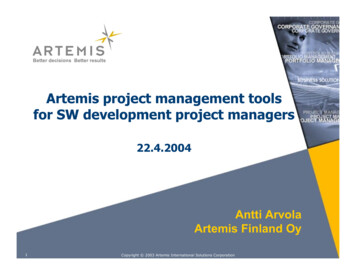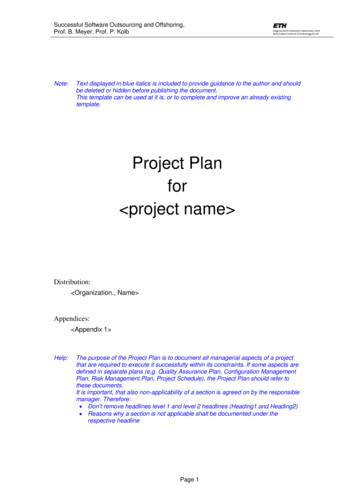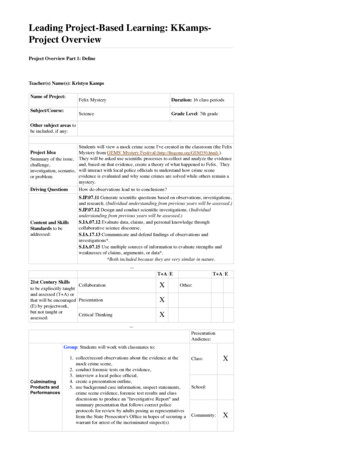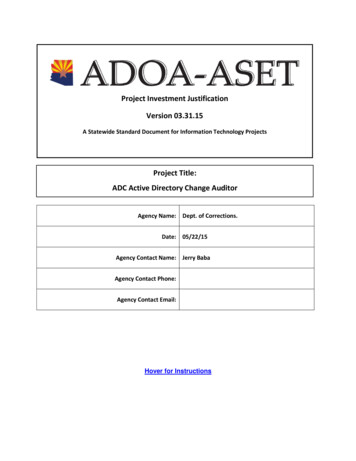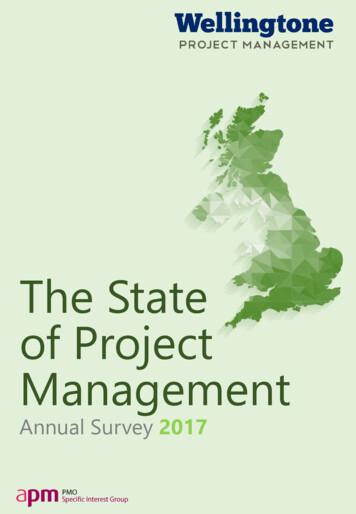
Transcription
The Stateof ProjectManagementAnnual Survey 2017
The State of Project Management Survey 2017ContentsForeword3Introduction5Headlines: 2017 v 20166Participants7Consistent Project Management Approach8Project Management Processes9Project Manager Skills & Experience10Project Management Maturity11PPM Solutions12PPM Information Sources13PMO Office15The CEB Imperatives for the PMO16PMO Status & Value17The Future PMO18PMO Maturity20Project Performance23About the Survey25About Wellingtone Project Management26[2]
The State of Project Management Survey 2017Foreword from MicrosoftProject management is very much at the heart of everything we do atMicrosoft. Partnering with our customers to help them achieve their business goals byleveraging project management best practices is a top priority for our organization. AtMicrosoft, we walk the same path as our customers and partners; being a globalorganization in constant evolution, we also deal with internal projects such as softwaredevelopment, data center & infrastructure builds, marketing activities, and businesschanges. In order to maximize our chances of success and deliver on our own projectgoals, in addition to using our own tools (such as Microsoft Project Online), weleverage project management best practices.This report provides a fascinating insight into the current state of project managementacross businesses in the UK. I highly recommend all of those involved in projects toread it.Angela Byers Worldwide Product Marketing Lead;Microsoft Project & Project OnlineMicrosoft[3]
The State of Project Management Survey 2017Foreword from the APM PMO SIGAccording to our 2017 results, 14% more organisations than last year now have a PMOin place in some form or another. It is also great to see that almost half of respondentswitness their PMO being respected as a value adding business partner.Unfortunately the maturity of project management in organisations, along with thesatisfaction of that level of maturity remains proportionally the same.This is because of the changing nature of PMOs in todays world. The imperatives laiddown by the Association for Project Management in 2015 have seen a rise in PMOinvolvement since last year almost across the board – the ones lagging behind?Predictably Project Prioritisation, Resource Management, and Capacity Planning alongwith supporting a career path for project management.The latter, being quite new to the PMO party is not a concern, the ability to obtain thelevel of support from executive sponsorship to change into a capability driver is stillhard-going for some organisations.The real issue is with the remaining key pieces that could complete a lot of PMOjigsaws out there. This is potentially why the maturity has stalled, and a reason tochange up the conferences and events that are aimed at challenging and developingthese areas into something more practical for our project peers.A third of PMOs are doing this internally by fostering a culture of project managementand capitalising on strong sponsorship.The future of the PMO? Uncertain for some, challenging for most with a predictionthat responsibilities and scope will rise, but with circa 50% of staffing remaining thesame. Can we really do more with the same? Sure, as long as it’s more of the same.Emma-Ruth Arnaz-Pemberton ChairAPM PMO SIG[4]
The State of Project Management Survey 2017IntroductionThe State of Project Management is an annual report published by Wellingtone ProjectManagement and the Association for Project Management (APM) Project ManagementOffice (PMO) Specific Interest Group (SIG).Although a number of non-salary focused project management surveys are publishedeach year they tend to be either very US centric or global in perspective. Our UKproject management industry is highly developed and deserves special attention.We invited colleagues from across our project management industry to participate, andthey did, in their hundreds! This is the largest annual non-salary focused projectmanagement survey in the UK.The State of Project Management survey asks questions across a number of importanttopics including; project management maturity, tools & techniques, project successrates and of course PMO maturity.You are very welcome to share this report with colleagues across our industry. Itprovides a fantastic insight into the state of project management in the UK.In writing this report I was keen to provide short focused commentary on the datarather than making you wade through pages of text. As a minor point of clarificationwhere I have used the term “Project Management” I have done so as a generic catchall and am referring to project, programme & portfolio management. The data shouldspeak for itself and although it highlights the great successes achieved by some itclearly shows there is much work to be done! Almost every organisation can benefitfrom improving their project management maturity. I hope this report provides thecatalyst for you to consider how you can increase your project successes.Thank you to all those professionals who contributed to this important and invaluableresearch data. Please do contact me with your thoughts on the survey and this report.Vince Hines Managing DirectorWellingtone Project Managementvince.hines@wellingtone.co.uk[5]
The State of Project Management Survey 2017Headlines 2016 v 201724%increase insurveyparticipants10%increase anisationshave a PMO,up from 71%in 2016Developing or have PMO strategy?2016201765% 52%Project performanceDelivered on timeDelivered project benefitsDelivered on budgetDifficult PM processes to embed Benefits management Lessons learned Change control Resource management10%decrease inPM maturitysatisfactionBiggest challenges Poorly trained PMs Running too many projects Lack of snr mgt support Poor resource management50%201632%31%31%increase inuse ofMicrosoftProjectOnline PPMsolution201737%35%42%[6]
The State of Project Management Survey 2017Participants768 professionals participated representing392 organisationsThank you to all those who participated from across our profession.Respondents tended to be highly experienced, professionally qualifiedproject management practitioners from across a wide spread of industriesand UK geographic regions. The average participant is a Project Managerwith at least one professional qualification (most likely PRINCE2) who isan employee of a large organisation[7]
The State of Project Management Survey 2017Consistent Project Management ApproachA strong indicator of project management maturity is the application of aconsistent methodology. Are all projects of a similar size & scale run in asimilar way, or is the approach driven by the selected Project Manager?Participants were asked a series of questions about the application ofconsistent methods and their frequency of useExactly the same as 2016, approx.34% of projects schedules are notbaselined. Baselining should occur atthe end of the Planning Stage. Actualprogress can then be tracked againstthe baseline plan. PMs should notonly know where they are in the plan,but also where they are compared towhere they should be!Approximately 60% of projects mostly or always have a scopingdocument, a defined methodology and undertake risk management.This represents a small improvement over 2016. There are howeversignificant numbers of projects that do not benefit from these bread andbutter principles with 27% sometimes or never creating a scopingdocument. Even across professionally qualified experienced PMs there istherefore room for improvement[8]
The State of Project Management Survey 2017Project Management ProcessesWe asked the question; “in your experience what typical projectmanagement processes are the most troublesome to embed?”Respondents were asked to select their top 3Benefits realisation has been a “hot” topic in project management forsome time. Over 51% of respondents highlighted this as troublesometo embed, an increase from the 45% stated in 2016. We anticipatedresource management would feature strongly but change control &lessons learned are also key challenges. Risk management also receivinga much higher score than in 2016[9]
The State of Project Management Survey 2017Project Manager Skills & ExperienceMany projects are not run by a recognised “professional” Project Managerbut rather a Subject Matter Expert (SME) who has been given thechallenge of running a project in their area of expertise. Often peopletherefore undertake projects will little or no formal training. We askedabout what type of people run projects and whether their organisationinvests in project management trainingNot surprisingly, given our pool of respondents, there was a highpercentage of “professional PMs” undertaking projects. Still, even withinthis pool 24% of projects are always or mainly undertaken by SMEs. Thisis fine if they receive appropriate training but significantly approx. onethird said “No” or “Don’t know” when asked about projectmanagement training[10]
The State of Project Management Survey 2017Project Management MaturityWe can measure the maturity of an organisation to see “how good” it is atproject management. A standard 5 level maturity model is shown below.Respondents were asked to grade their department and organisation as awhole on their maturity. People are often over-optimistic about maturityand the more telling question relates to whether they are happy with thecurrent level of maturity50% of respondents are somewhat or very dissatisfied with thecurrent level of PM maturity in their organisation. This represents aincrease from the 45% recorded last year. This is a significant figure anddemonstrates the scale of the opportunity for improvements. Themajority of organisations should aim to achieve level 3 as a minimum sowith 43% of organisations at a maturity level of 2 or below, it is nosurprise that we find so many dissatisfied respondents[11]
The State of Project Management Survey 2017PPM SolutionsThose involved in projects, as with all business functions, can benefit fromhaving the right software tools. We asked questions about which toolsrespondents use and the benefits they derived from these tools. Manyorganisations have, or are thinking about, deploying a Project & PortfolioManagement (PPM) solutions50%more organisations havedeployed MicrosoftProject Online / Servercompared to last year. Noother PPM solutionshowed any significantusage growth42%receive some, most orall benefits from theirsoftware investmentOver 1/3rd of organisations do not yet make use of a PPM solution.The PPM solution showing the most significant growth in usage isMicrosoft Project Online with a 50% increase in adoption over 2016. Thisis no surprise given the success of Microsoft Office 365 and take up ofcloud solutions. Microsoft Project Online can be quickly setup on its ownor added to an existing Office 365 tenant.[12]
The State of Project Management Survey 2017PPM Information SourcesThis year we have built on the original PPM software questions tounderstand more about how much time people spend collating projectstatus reports, who has access to project KPI data and how organisationsattempt resource management. Three key topics relating to PPMsolutions16%47%55%of organisations usean appropriateresourcemanagement solutionof people spend 1day or morecollating projectreports each monthof organisations donot have access toreal time KPIsNo wonder so many organisation struggle to get to grips with resourcemanagement with only 16% making use of an appropriate softwaresolution. Also disappointing was the amount of time respondents spendcollating manual project status reports with over 1/5th spending morethan 2 days a month on this time consuming activity. Informed decisionmaking is difficult when 55% of organisations do not have access to realtime project KPIs. There is much room for improvement[13]
Project OnlinePlanning &SchedulingProject & .co.uk/projectAgileCollaborationModernize the approach to Project Management across the entire organization!Project CollaborationProject ManagementPortfolio ManagementWork ManagementVisibility and ControlAudience:Team MembersAudience:Resource and Project ManagersAudience:PMO, Executives and PortfolioManagersWeb-based interface for team membersRich user interface through desktopclient (always latest version/ 5installations per subscription)Portfolio selection and optimizationAnytime/anywhere access through WebinterfaceEnterprise resource managementUpdate tasks, issues, and risksSubmit timesheetsShare documents and collaborate withSkype for Business presenceProject scheduling and costingAlignment with BusinessObjectivesDemand managementOut-of-box portfolio reportsResource managementPublishing projects to the cloudProject Online EssentialsProject Online ProfessionalProject Online PremiumJoin & Share the UK Project Community – www.microsoft.co.uk/projectFree webinars and other resources to support the adoption of better Project Management tools and methodologies.
The State of Project Management Survey 2017PMO OfficeWe asked a series of questions related to the state of the PMO, obviouslya core interest for the APM PMO SIG. We started by asking about theexistence of a PMO or PMOs and their scope of work. Different terms areused across industry for a range of similar permanent entities that overseeproject activities. Here we are using the term PMO as a generic name tocover PMO, PSO, Programme Office, Portfolio Office, Projects Office or PMCentre of ExcellenceGot PMO?201785%201671%We have seen strong growth in the setup of PMOs over recent years. 85%of organisations now have a single or multiple PMOs, compared with71% just last year. On page 8 we listed processes that were the mostdifficult to embed, the highest being “benefits tracking”. Here we see“benefits tracking” as the least likely to form pa
The State of Project Management Survey 2017 24% increase in survey participants Difficult PM processes to embed Benefits management Lessons learned Change control



